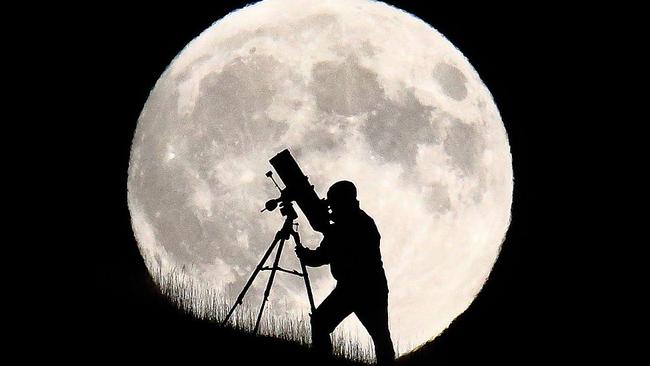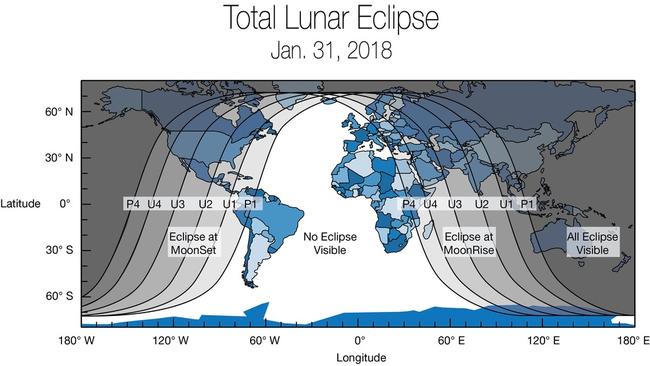All you need to know about the rare ‘super red blue moon’
AN EXTREMELY rare lunar trifecta is set to appear in the sky tonight and this is how to see it.
IT’S been called a once-in-a-lifetime lunar trifecta and Aussies will have one of the best seats in the house when it takes place tonight — provided the clouds stay away.
The world is set to witness a genuinely rare cosmic event dubbed the “super red blue moon” or “super blue blood moon” as three lunar phenomena happen to converge at the same time. Everyone from amateur stargazers to the folks at NASA are getting excited as the event draws near.
According to astrophysicist Dr Stephen Hughes from the Queensland University of Technology it’s even rarer than some think and won’t be visible again from Brisbane for more than 400 years.
In fact Dr Hughes said tonight’s super blue blood moon will be extra special because the moon will pass through perigee at the same time as the eclipse totality, which is when the moon is in the deepest shadow.
“Maybe we should call this a super true blue blood moon,” he said. “From my research, the last of these super true blue blood moons visible in the skies above Brisbane would have been back in 1592BC.”
‘EXTREMELY UNUSUAL OCCURRENCE’
“The title ‘super red blue moon’ sounds a bit peculiar, but it describes an event where three separate lunar conditions come together simultaneously,” said Professor Bill Boyd, from the School of Environment, Science and Engineering at Southern Cross University.
Each of the lunar events have their own life cycle but this year they all happen at the same time.
Prof Boyd said: “Barring cloud cover, we will get as good a view as anybody in the world, here in Australia, certainly on the east coast.”
A super moon occurs at the point when our moon reaches its closest distance to Earth during its elliptical orbit, some 25,000km closer than average. As a result, it appears much bigger and about 30 per cent brighter.

As for the red part, that happens during a lunar eclipse when the sun, earth and moon align and the moon passes directly through the earth’s shadow.
“The spectacular thing this time is that it’s going to pass fully into the middle of the shade, and as it does it gets more and more covered in shadow,” Prof Boyd said. But instead of going dark, the way the sunlight refracts around the Earth gives the moon a red hue as some of the sunlight entering Earth’s atmosphere, notably the red spectrum, is scattered in a way that gently illuminates the moon behind.

As for the blue, that’s somewhat of a misnomer. Instead of referring to a visible colour, it is a name commonly used to describe a second full moon in a month.
“Normally we get one full moon in a month but the lunar cycle — the lunar months if you like — are slightly shorter than the solar ones, and so we have an extra moon every now and then.”
Traditionally the term referred to a fourth full moon in a season “but it’s now come to be thought of as the second moon in a month,” Prof Boyd said.
BEST WAY TO SEE IT
The event will take place in the middle of the night on Wednesday, January 31.
Across the NSW north coast and Gold Coast, the super red blue moon starts at 10.48pm eastern daylight savings time (AEDT), eclipsing fully from 11.51pm to 1.07am, and ending at 2.11am. (Queensland viewers will need to shave an hour off those times.)
The best place to see it will be on the east coast of the country with a good view to the north, provided the clouds stay away. The further away from artificial light the better and it’s not a bad idea to take some binoculars if you’ve got them to get the best view.
Those on the west coast won’t miss out entirely and will be able to catch a good glimpse of the moon from 7.48pm to 11.11pm.
For those who can’t make it out (or just prefer to catch a glimpse from the comfort of bed) it will also be live streamed on the news.com.au homepage from 10pm.

As for Prof Boyd, he was planning to set up shop on a nearby headland on the east coast with a good vantage point to the north but after hearing about a group of local stargazers in Lismore, it might turn out to be a rather more festive event than he first thought.
“These are amateur stargazers and apparently they’re talking about setting up an event where I assume they’ll get out their telescopes and make a bit of a party of it,” he said. “I think there’s going to be these little parties all over the place. I’ve been told the lighthouse at Byron Bay is likely to be extremely popular.”
You can check with your local amateur astronomy groups about viewing parties being held tomorrow night.
Avid stargazers and celestial photographers are chomping at the bit and for good reason as they might not get another chance to witness the phenomenon.
“This is an extremely unusual occurrence. It will be unlikely for all three celestial events to converge again within the next century,” Prof Boyd said.
BEST WAY TO CAPTURE IT
Steven Morris runs Nikon’s Astrophotography workshop in Adelaide and the Blue Mountains and has shared his tips with news.com.au on how to best capture the lunar event.
First of all, plan your shoot, he says. “Do you want to shoot a transition of the moon over a landscape or do you want to shoot the moon at a long focal length?”
Once you’ve answered that question, you need to consider your aperture, shutter speed and ISO settings.
• You will want your camera in manual mode.
• Aperture around F/8.
• Set your shutter speed and don’t adjust it throughout the night to keep image sharp.
• Shutter speed of around 1/250th is a good start point.
• As the moon gets darker the only thing you want to adjust to get a nice exposure is your ISO.
“Make sure you’re using your tripod for added stability,” he said. “And if you have a shutter release cable, use it. If not then use the timer function on your camera to reduce vibration in your image.”



